The city that makes the most expensive boats in the world
Wandering along the beach in Italy's Viareggio you could be forgiven for thinking it's simply a holiday resort.
Yet the umbrella-lined, sandy beaches dotted with tourists mask another role, one at the heart of the shipping industry.
This unassuming seaside city is where some of the world's largest and most exclusive vessels are made.
Its speciality is the superyacht. These giant crewed vessels start at about the length of an average swimming pool - 24-metres. But the biggest can stretch to five or more times this.
It's a world that belongs to only the very wealthiest of the wealthy - to buy a superyacht you have to be super rich.
Just 370 superyachts were sold last year around the globe, yet collectively these sales were worth a staggering 3.4bn euros (£3bn; $4bn).
The most expensive superyacht sold so far this year cost 155m euros, according to Boat International which collates the industry data.
Viareggio is where about a fifth of these gigantic elite boats are made. It's the "cradle of shipbuilding" is how the city's mayor Giorgio del Ghingaro sums it up.
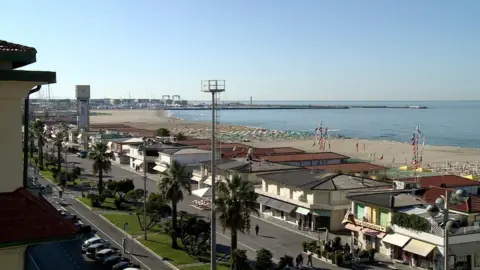
In fact, the town's involvement in the industry goes back almost 200 years to 1819 when the first dock was built. Viareggio started to build large, strong wooden ships to transport the marble from the region's famous quarries. This laid the foundations for what would eventually become a major international shipping industry with a history of carpentry and craftsmanship.
The growing popularity of the superyacht has meant Viareggio has evolved again, shifting from making the wooden boats it was once famous for to constructing these giant metal and fibreglass vessels.
Vincenzo Poerio, the chief executive of shipbuilding firm Benetti, which is headquartered in Viareggio, believes the region's artistic roots have helped to drive its success in the industry.
Tuscan cities such as Lucca, Pisa, Siena and Florence are renowned for their craftmanship in marble, wood, leather and architecture. And people in the market for buying a superyacht expect everything - the interior as well as the exterior - to look perfect.
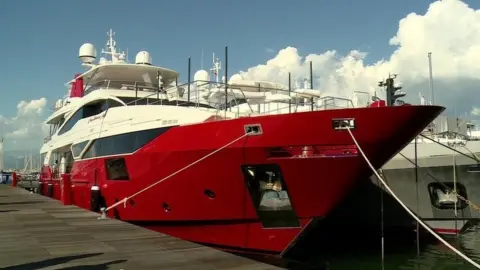
Of course you need more than artistic flair to build a superyacht. For such large and expensive projects, engineering skills are crucial as are project management expertise to ensure the boat is built on time and on budget.
But Mr Poerio says the most important attribute to be successful in this industry is people skills to enable them to deal with the often "challenging" demands of the super rich.
Maintaining good relations matter because it's a personal transaction, not a business one, he says:
"At the end of the day, you are building a big toy, probably the most expensive toy in the world."
In contrast to similar industries such as luxury cars or private aircraft, it's much harder to build these vessels in a standardised way.
"In our case most of the time we start from scratch. So the client is not buying a product, he's building a product which makes a huge difference… Most of the time it's not easy to manage these requests," says Mr Poerio.
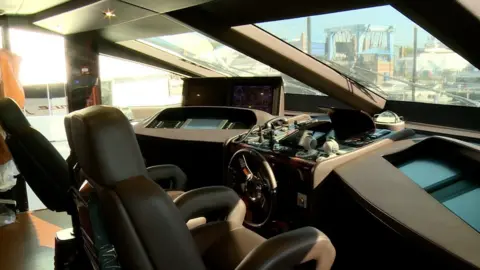
This approach is now starting to shift, with some shipbuilders including Benetti and Perini Navi, building smaller superyachts without first receiving an order.
For their wealthy customers, used to getting things when they want them, an instantly-available boat is a big attraction.
But for the firms investing millions when they don't yet know if they'll be able to find a customer it is a risky strategy.
Yet Burak Akgul, a managing director at shipbuilder Perini Navi, says he's not worried.
"We are an indulgence. There's always someone who's ready to indulge, it's just a matter of whether or not we manage to get hold of them," he jokes.
In fact, he says, the brand Perini has become a sort of status symbol, marking a certain level of achievement.
"We started seeing people expressing themselves as having reached the point where they now need to have their Perini.
"They didn't know what they wanted yet, but they had this feeling that they had come to the point of their personal success that time had come for them to build a Perini this was something they had to add to their stable," he says.
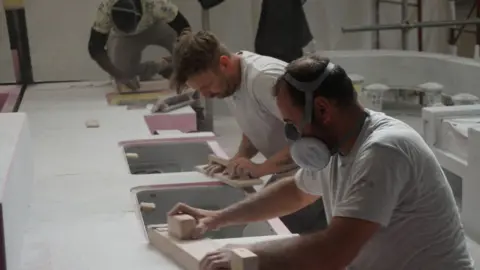
One other advantage for Viareggio is that it is already well equipped to cope with the vagaries of the superyacht industry, which because it is so small and specialised can see demand fluctuate wildly depending on the wider economy.
The skills required to build a superyacht are similar to those for a military boat with both of similar sizes.
Massimo Perotti, owner of ship builder San Lorenzo, says this is a useful balance, with demand for pleasure yachts naturally reducing when military vessels are required and vice versa.
Nonetheless, the extreme wealth of their clientele means they're also more cushioned from the impact of world events. Even in the financial crisis, San Lorenzo managed to expand, selling about 20 yachts, partly by targeting new markets in Russia, South America, Brazil and India.
The crisis did, however, mark a shift in their customer base. Instead of getting people who wanted a superyacht to show how rich and powerful they were he says, most customers are now genuinely interested in boating.
Yet even with a flow of wealthy customers ready to indulge, the Italian industry is facing competition from other rivals within Europe and even China. Lower labour costs and raw materials mean these countries are able to produce a cheaper boat.
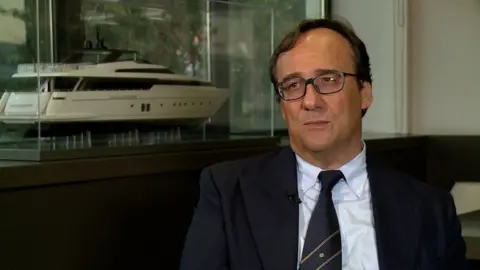
But Benetti's Mr Poerio says that for the "very, very, very rich people" they cater for, price isn't what matters.
When people are spending millions and millions of euros "the brand has to mean something," he says.
He believes things like the customer relationships and service they offer, as well as the guarantee of a certain level of quality, means they should be able to keep customers from going elsewhere.
San Lorenzo's Mr Perotti agrees: "If you buy a superyacht it's for yourself. You like technology, design, luxury; you know, it's not cheap and you are not looking to to have it at the lowest cost."
In the end, it comes back to what Viareggio has always been renowned for - artistic flair.
"The characteristic of the Italians is individualism and creativity. Maybe you buy a German car because the Germans are better in organisation. But if you want to buy a piece of art you probably go to Italy."
This feature is based on interviews by series producer Neil Koenig, for the BBC's Life of Luxury series.
